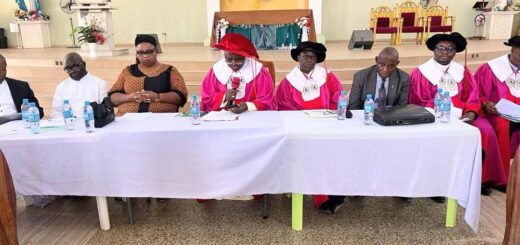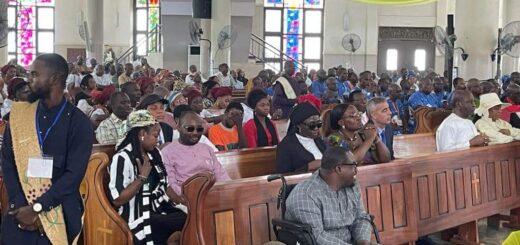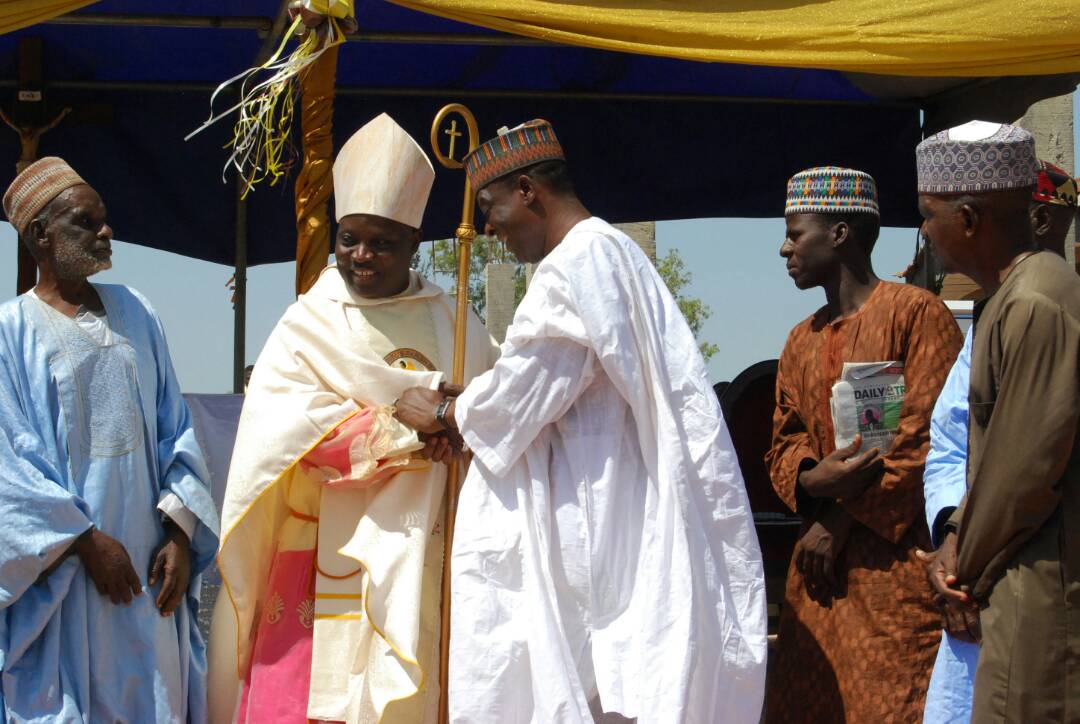Homily of the Papal Nuncio to Nigeria, H.E Archbishop Antonio Guido Filipazzi, at the Mass of Imposition of Pallium on His Grace, Most Rev. I. A. Kaigama
by ARCH BISHOP · August 27, 2020
Homily of the Papal Nuncio to Nigeria, H.E Archbishop Antonio Guido Filipazzi, at the Mass of imposition of pallium on His Grace, Most Rev. Ignatius A. Kaigama, Archbishop of Abuja, at Our Lady Queen of Nigeria, Pro-Cathedral, Abuja. 27.08.20
1. Nine months have passed since Archbishop Ignatius Ayau Kaigama solemnly began his ministry as Archbishop of Abuja in the new Cathedral of the Twelve Apostles. Today we are gathered here in prayer because he has just received the pallium as Metropolitan of the Ecclesiastical Province of Abuja.
For my part, I am grateful to the Holy Father for wanting me not only as Apostolic Nuncio to Nigeria, but also as his Representative to give the pallium to our dear Archbishop Kaigama. And now I would like to invite you to reflect briefly on the meaning and, therefore, on the message that comes from this liturgical sign, which distinguishes the Metropolitan Archbishops.
2. According to the Code of Canon Law, “the pallium signifies the power which the metropolitan, in communion with the Roman Church, has by law in his own province” (can. 437 § 1). Archbishop Kaigama had already received it as Metropolitan Archbishop of the Ecclesiastical Province of Jos, but the law of the Church stipulates that “a Metropolitan needs a new pallium if he is transferred to another metropolitan see” (can. 437 § 3). That’s why we are here today.
The pallium, therefore, refers both to the Ecclesiastical Province and to the bond with the Church of Rome.
a) “The particular Churches” are “brought together into ecclesiastical provinces”, “to promote the common pastoral action of different neighboring Dioceses” (can. 431§1). Particularly, these should permit and, at the same time, demand that the Shepherds of the Dioceses that form them keep in touch and act together, being solicitous not only of their own particular Church, but also of those that are closest to them. I am pleased to greet here the Bishops of the Ecclesiastical Province of Abuja, and during this celebration we want to pray for all the Dioceses belonging to the Ecclesiastical Province of Abuja: Gboko, Idah, Lokoja, Makurdi, Otukpo, Katsina-Ala and Lafia (for these latter two we also ask that the Lord may give them very soon a new Shepherd according to His heart). However, the ecclesiastical provinces are not just a way of organizing the collaboration: they are a manifestation and realization of that great and profound reality which is ecclesial communion, which is lived at different levels and in different forms. In particular, ecclesiastical provinces show and actualize the communion that exists among particular Churches, “in and from which churches come into being the one and only Catholic Church” (LG 23) and the communion of the bishops among themselves and “with Peter under Peter”.
b) Here is the other element which is recalled by the pallium: the communion with the Successor of Peter. The Church of Christ spread over the whole earth is one Church, and this unity of the Church is visibly guaranteed by the Supreme Pontiff. The Metropolitan Archbishop who carries the pallium, has the task of helping above all his own Archdiocese and the Suffragan Dioceses to live in communion with the whole Church and her visible Head. As Benedict XVI said, “the pallium…means quite concretely the communion of the shepherds of the Church with Peter and with his successors – it means that we must be shepherds for unity and in unity, and that it is only in the unity represented by Peter that we truly lead people to Christ” (homily, 29.6.2011).
The pallium is, therefore, a sign and an invitation to live the communion in the Church. We know that unfortunately this communion is a reality delicate and fragile. This happens when what keeps us united and is more important than our differences are not faith, charity, prayer, mutual service, witness of life, but other goals and interests. In this way, unfortunately, our communities are divided within themselves, because we give pride of place to our kinship or friendships, our ethnic group, our ideas, projects and objectives, our selfish interests… This gives rise to parties, fights, calumnies, and hatred. An old Christian author wrote that the pagans, looking at the first Christians, exclaimed: “See how they love one another!” (Tertullian, Apologeticum, 39). Today, can those who look at our communities from outside say the same thing? And let us not forget that Catholics must also be builders of harmony in society, of which they are members and in which there are also many harmful divisions.
May Archbishop Kaigama’s pallium strongly call us to pray and to work to fulfil what the Church sings in the ancient hymn “Übi caritas”: “Simul ergo cum in unum congregamur:/ Ne nos mente dividamur, caveamus./ Cessent iurgia maligna, cessent lites./ Et in medio nostri sit Christus Deus” – ” Whensoever we are gathered as one:/ Lest we in mind be divided, let us beware./ Let cease malicious quarrels, let strife give way/ And in the midst of us be Christ our God!”
3. Without true communion it becomes difficult, if not impossible, to carry out the mission that Christ entrusted to His disciples. As Saint John Paul II recalled, “communion and mission are profoundly connected with each other, they interpenetrate and mutually imply each other, to the point that communion represents both the source and the fruit of mission: communion gives rise to mission and mission is accomplished in communion” (Christifideles laici, 32).
Now, the pallium also symbolically illustrates the mission of the Metropolitans and of all the Shepherds of the Church, indeed in some aspects that of every disciple of the Lord and, therefore, of the whole Church.
a) As you know, the pallium is woven from the wool of the lambs. The lamb, the sheep and, correlatively, the shepherd are images that often recur in Sacred Scripture and that Jesus applied to Himself and to His mission. In fact, Jesus is, at the same time, the Lamb of God who takes away the sins of the world and is the Good Shepherd, who goes in search of the lost sheep and who offers His life for His sheep. Therefore, the pallium, placed on the shoulders of the Archbishop, “reminds us of Christ himself, who, as the Good Shepherd, took the lost sheep, humanity, on his shoulders to bring it home. It reminds us that he, the supreme Pastor, wanted to make himself the Lamb, to take upon himself from within the destiny of us all; to carry us and to heal us from within” (Benedict XVI, homily, 29.6.2009). As Pope Francis said, the pallium “is a sign that the Shepherds do not live for themselves but for the sheep. It is a sign that, in order to possess life, we have to lose it, give it away” (homily, 29.6.2019).
If the task of the Shepherds of the Church is to go in search of every brother and sister and to bring them to Jesus, however this is not only up to the Bishops, priests and consecrated persons. According to St. John Chrysostom, Jesus asks the question: “Do you love me?” and entrusts the mission: “Feed my sheep”, “not only to the priests, but to each one of us, for small to be the flock entrusted to us… Each of us has a sheep” (sermon 77 on Matthew). Yes, each one of us, each Christian, has his family, friends, and acquaintances, colleagues, who are that flock that every baptized person must bring to Jesus by prayer, example, word and self-sacrifice.
b) Moreover, the pallium is placed on the shoulders like a yoke, i.e. the instrument that is used to guide the work of the animals in the fields. Jesus said to His disciples: “Take my yoke upon you… For my yoke is easy, and my burden light” (Mt 11, 29-30). The pallium “may be considered an image of the yoke of Christ… God’s yoke is God’s will, which we accept. And this will does not weigh down on us, oppressing us and taking away our freedom. To know what God wants, to know where the path of life is found – this was Israel’s joy, this was its great privilege. It is also our joy: God’s will does not alienate us, it purifies us – even if this can be painful – and so it leads us to ourselves” (Benedict XVI, homily, 24.4.2005).
Therefore, the pallium reminds all Bishops, priests and consecrated persons that they truly serve God’s people only if they commit themselves to follow God’s will, not theirs or that of the world. “Christ’s yoke is identical with his friendship. It is a yoke of friendship and therefore “a sweet yoke”, but as such it is also a demanding yoke, one that forms us. It is the yoke of his will, which is a will of truth and love. For us, then, it is first and foremost the yoke of leading others to friendship with Christ and being available to others, caring for them as shepherds” (Benedict XVI, homily, 29.6.2011).
But even every Christian must carry the yoke of the Lord, that is, do His will, which, instead, we often look upon as a burden, which we often carry out with a sad heart, trying to reduce it to a minimum, if not to avoid it. Instead, we must understand and appreciate how lucky we are enjoying the demanding but saving friendship with the Lord Jesus. In the end, we will discover that the yoke of Jesus is what carries us, more than what we carry!
4. The pallium received by the Archbishop of Abuja speaks, therefore, to him and to all of us, each according to his/her vocation, of communion in the Church, of mission in the world, of friendship with the Lord Jesus.
Today the Church remembers St. Monica, the mother of the great Bishop and Doctor of the Church St. Augustine. She was wife, mother and widow. In her not easy life she put in practice, especially within her family, the message of the pallium: she faithfully loved and followed Jesus and through prayer, word and sacrifice she led her son, as well as her husband, to the friendship with Him. May the example of St. Monica inspire Archbishop Kaigama and all of us and may the intercession of this holy woman help us to live more and more communion, mission and friendship with Jesus




